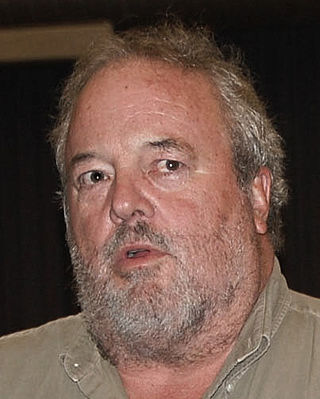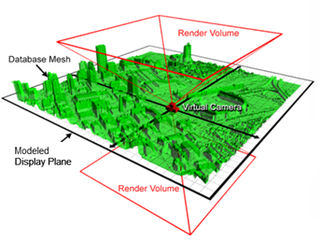
Holography is a technique that enables a wavefront to be recorded and later reconstructed. It is best known as a method of generating three-dimensional images, and has a wide range of other uses, including data storage, microscopy, and interferometry. In principle, it is possible to make a hologram for any type of wave.

The Holodeck is a fictional device from the television franchise Star Trek which uses "holograms" to create a realistic 3D simulation of a real or imaginary setting, in which participants can freely interact with the environment as well as objects and characters, and sometimes a predefined narrative.

A 3D display is a display device capable of conveying depth to the viewer. Many 3D displays are stereoscopic displays, which produce a basic 3D effect by means of stereopsis, but can cause eye strain and visual fatigue. Newer 3D displays such as holographic and light field displays produce a more realistic 3D effect by combining stereopsis and accurate focal length for the displayed content. Newer 3D displays in this manner cause less visual fatigue than classical stereoscopic displays.

Vizrt, short for Visualization in Real-Time or Visual Artist, is a Norwegian company that creates content production, management, and distribution tools for the digital media industry. It's products includes applications that create real-time 3D graphics and maps, visualised sports analysis, media asset management, and single workflow solutions for the digital broadcast industry.

Allan Alcorn is an American pioneering engineer and computer scientist best known for creating Pong, one of the first video games. In 2009, he was chosen by IGN as one of the top 100 game creators of all time.
Dejarik, also known as holographic chess or holochess, is a primarily-fictional board game appearing in the Star Wars space opera franchise that uses holographic figures as pieces. The game has been roughly described as that universe's equivalent of terrestrial chess since it is played on a board with a chequered pattern, each piece has a specific way of moving and attacking, and if it lands on a spot occupied by an opponent, it destroys the other piece. Over the years, several official and fan-made replicas have been made. As of 2021, no single, official rule set for the game has been released, and instead, a number of different rule sets for the game co-exist. Even the number of figures to be used in the game is unclear, although the best known variant uses eight.

Holographic data storage is a potential technology in the area of high-capacity data storage. While magnetic and optical data storage devices rely on individual bits being stored as distinct magnetic or optical changes on the surface of the recording medium, holographic data storage records information throughout the volume of the medium and is capable of recording multiple images in the same area utilizing light at different angles.

A hogel is a part of a light-field hologram, in particular a computer-generated one. It is considered a small holographic optical element or HOE and that its total effect to that of a standard hologram only that the resolution is lower and it involves a pixelated structure. An array of these elements form the complete image of a holographic recording, which is typically displayed in 3D free-viewing device.
Computer-generated holography (CGH) is a technique that uses computer algorithms to generate holograms. It involves generating holographic interference patterns. A computer-generated hologram can be displayed on a dynamic holographic display, or it can be printed onto a mask or film using lithography. When a hologram is printed onto a mask or film, it is then illuminated by a coherent light source to display the holographic images.

Stephen Anthony Benton was the inventor of the rainbow hologram and a pioneer in medical imaging and fine arts holography. Benton held 14 patents in optical physics and photography, and taught media arts and sciences at Massachusetts Institute of Technology (MIT). He was the E. Rudge ('48) and Nancy Allen Professor of Media & Sciences, and the Director for Center for Advanced Visual Studies (CAVS) at MIT.
A holographic display is a type of 3D display that utilizes light diffraction to display a three-dimensional image to the viewer. Holographic displays are distinguished from other forms of 3D displays in that they do not require the viewer to wear any special glasses or use external equipment to be able to see the image, and do not cause the vergence-accommodation conflict.

Security holograms are labels with a hologram printed onto it for sale security reasons.

Zebra Imaging was a company that developed 3D digital holographic images, hologram imagers and interactive 3D displays for government and commercial uses. The company offers digital holograms that are autostereoscopic, full-parallax and in monochrome or full-color. They have also developed a 3D Dynamic Display, which is capable of rendering holograms in real time; design work with 3D programs such as SketchUp and 123D Catch can be viewed on a holographic display while they are actively being edited.
Specialized Enterprise Holography Ltd. (SE Holography) is a company that specializes in production of holograms and holographic security elements. Holography, a member-company of the EDAPS Consortium, is among the founders of the security printing industry in Ukraine. Established in 2000 with the support of the International Centre the Institute of Applied Optics on behalf of the National Academy of Sciences of Ukraine. Holography Ltd. is a member of the International Hologram Manufacturers Association (IHMA), a member of the International Society for Optical Engineering (SPIE) and a member of the Counterfeiting Intelligence Bureau at the International Chamber of Commerce of Ukraine.

Yves Gentet is a French engineer and artist, known for the invention of a creative method of holograms in colour Ultimate and a 3D holographic printer Chimera.

Euclideon Pty Ltd is an Australian computer software company known for a middleware 3D graphics engine, called Unlimited Detail. Euclideon is also the parent company and operator of Holoverse, a 'holographic entertainment centre' located on the Gold Coast, in Queensland, Australia. Euclideon claims that Unlimited Detail is based on a point cloud search engine indexing system and that the technology can provide 'unlimited graphics power', proposing it as a replacement for polygon-based rendering.
Holography is often used as a plot device in science fiction, appearing in a wide range of books, films, television series, animation and video games. Probably the first reference is by Isaac Asimov in his Foundation series staritng in 1951.

Windows Mixed Reality (WMR) is a discontinued platform by Microsoft which provides augmented reality and virtual reality experiences with compatible head-mounted displays.
Holoverse is an amusement attraction on the Gold Coast, Australia, that opened in June 2016.
Project Starline is an experimental video communication method currently in development by Google that allows the user to see a 3D model of the person they are communicating with. Google announced the product at its 2021 I/O developer conference, saying that it will allow users to "talk naturally, gesture and make eye contact" by utilizing machine learning, spatial audio, computer vision and real-time compression to create the 3D effect without the user wearing typical virtual reality goggles. The goal is to make the user feel as if they are in the same room with the other user.











